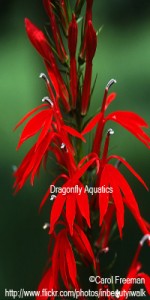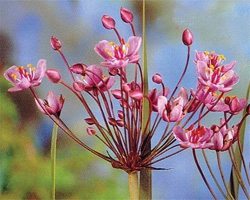I'm not certain of the identity of this butterfly. I thought perhaps it was a male Eastern Tiger Swallowtail. I'm really not certain, although it sure liked my dwarf crab-apple tree. It came back day after day.....I'm thinking it was the same one.
I know we don't want to think about it but it won't be long and fall will be here and we all know what comes next.....its time for us to be thinking about taking the extra care with our pond plants to make them comfortable for the winter cold. I've noticed the butterflies aren't as plentiful as they had been but occassionally I'm able to catch one.
HARDY BOG/MARGINAL PLANTS
Once your hardy marginal plants begin to brown, usually after the first hard frost, prune back excess foliage and discard any decaying material, so it does not compromise the water quality over the winter months. Potted bog plants such as Pickeral, Thalia Dealbata, and Japanese Variegated Iris should be placed at a sufficient depth to avoid freezing the crown of the plant. Most of the other hardy bog plants can be left as they are and will return the following spring.
Tropical Bog Plants
Many of the tropical bog plants will winter well indoors in a sunny window or with a grow light. They do not need to be submerged in water. Keep the soil constantly moist by placing the potted plants in a tray of water.
 I thought I'd publish this article we wrote last year again. When trying to get some of the bog plants started in your ponds its best to start them out slowly in the water, since most of them are swamp like plants. They can tolerate a few inches above their pot once they are established and growing. When growing them in our greenhouses we have them growing in two inch net pots in bins that have about one inch of water in them so the water is keeping their roots wet.
I thought I'd publish this article we wrote last year again. When trying to get some of the bog plants started in your ponds its best to start them out slowly in the water, since most of them are swamp like plants. They can tolerate a few inches above their pot once they are established and growing. When growing them in our greenhouses we have them growing in two inch net pots in bins that have about one inch of water in them so the water is keeping their roots wet.
Here's the article.
I've been wanting to write something on this subject for some time now. Finally, I have a bit of time to address the subject of water depth for bog plants and marginal plants. Simply put, bog plants like their "feet" wet. Translation....roots and soil moist at all times. When the plants are first planted, this is especially important. Many of the bog plants will take deeper water as they mature and spread. But, when you first receive your bog plants, you will have better success if you place them where there is no more than a half inch or less of water above the soil line. Think of the marshes and swampy areas, you have passed while traveling down the road. These natural reservoirs, fill during the rainy season and will dry out during dry spells. The plants adjust to the varying water depth and grow and spread rapidly. If you have a question on a particular plant, just ask and we will be happy to help you plant and grow beautiful marginal and bog plants.
 Flowering Rush (Butomus umbellatus) has blossoms that are much more impressive than its foliage, small delicate rose pink flowers. Graceful long green stems and atop a cluster of flowers. The flower is about 5" across ontop of 2' to 4' stems.
Flowering Rush (Butomus umbellatus) has blossoms that are much more impressive than its foliage, small delicate rose pink flowers. Graceful long green stems and atop a cluster of flowers. The flower is about 5" across ontop of 2' to 4' stems.
Flowering Rush usually start to bloom toward the end of spring or early summer. It may even rebloom in the cooler climates. It requires sun to part shade and moist to 3" of water. A very easy aquatic plant to grow. It is zone hardy to at least USDA Zone 3. It prefers colder climates and doesn't seem to like the hot, humid weather.
It is an excellent plant for informal ponds when interplanted with wider-leafed marginals; also grows well in wet spots or a bog area. If placed with a plant such as, Variegated Cattail or Zebra Bullrush, its stunning. Its form and texture lend itself well to a natural looking pond rather than a formal one. The pink flowers pop out amongst the variegated foliage of the cattail or rush. I wouldn't recommend it for a container plant as the water may get too warm for it.
Fertilize it once it begins to grow in the spring. Continue monthly with fertilizer until the plant begins to go dormant in the fall. In the summer after it has stopped flowering is the best time to divide the plant. Dig it up and trim back the foliage. You want to cut the rhizomes into pieces, each one being about 1" to 3" wide. Put the plant back into its space in the pond and replant the new just below the soil. New growth usually appears in about a week.
Buy Flowering Rush,Hardy Bog Plant here.